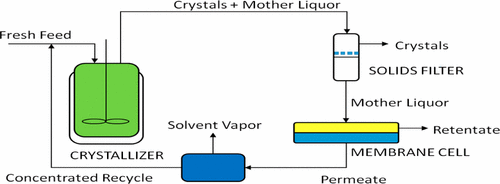当前位置:
X-MOL 学术
›
Cryst. Growth Des.
›
论文详情
Our official English website, www.x-mol.net, welcomes your
feedback! (Note: you will need to create a separate account there.)
Complexation-Assisted Continuous Crystallization of Isomeric Systems with Nanofiltration Recycle
Crystal Growth & Design ( IF 3.2 ) Pub Date : 2017-09-11 00:00:00 , DOI: 10.1021/acs.cgd.7b01030 Shankul Vartak 1 , Allan S. Myerson 1
Crystal Growth & Design ( IF 3.2 ) Pub Date : 2017-09-11 00:00:00 , DOI: 10.1021/acs.cgd.7b01030 Shankul Vartak 1 , Allan S. Myerson 1
Affiliation

|
In API-impurity systems consisting of structural isomers, the impurity has a strong affinity to incorporate into the host crystal owing to their identical molecular weight and similar structure. Conventional successive recrystallization turns out to be an unattractive purification strategy in such cases, since it can improve crystal purity only at the cost of yield. As an alternative, selective complexation of the impurity can sterically prevent its incorporation into the host lattice by increasing the apparent molecular weight and dimensions of the impurity. The increase in size of the impurity post complexation can be further exploited using a nanofiltration membrane to preferentially reject the complex in solution, while allowing the smaller molecules of uncrystallized API to permeate through. The crystallization yield can be enhanced by concentrating the permeate stream and recycling it back to the crystallizer. Thus, complexation-assisted nanofiltration recycle presents a strategy to improve both yield and crystal purity simultaneously in a continuous mode. In the present work, the application of this strategy is described for the continuous cooling crystallization of two isomeric systems in a mixed-suspension mixed-product removal (MSMPR) crystallizer. The first system consists of 4-nitrophenol with 3-nitrophenol as an added impurity in an aqueous solvent, while the second one consists of the active pharmaceutical ingredient (API) acetaminophen with its isomer 3-acetamidophenol added as an impurity in a mixed solvent of 50:50 ethanol and water by volume. A working strategy for selecting the complexing agent and nanofiltration membrane is discussed. For both systems, the complexation-assisted continuous mode with nanofiltration recycle performed better than both the batch process as well as the unrecycled MSMPR process in terms of higher crystallization yield and lower impurity incorporation in crystals.
中文翻译:

具有纳米过滤循环的异构体系统的络合辅助连续结晶
在由结构异构体组成的API杂质系统中,杂质具有相同的分子量和相似的结构,因此具有很强的亲和力,可以掺入基质晶体中。在这种情况下,常规的连续重结晶法是一种没有吸引力的纯化策略,因为它只能以收成为代价提高晶体纯度。作为选择,杂质的选择性络合可通过增加杂质的表观分子量和尺寸而在空间上阻止其掺入主体晶格中。使用纳滤膜可进一步利用杂质在络合后增加尺寸,以优先排斥溶液中的络合物,同时允许较小的未结晶API分子渗透。通过浓缩渗透物流并将其再循环回到结晶器,可以提高结晶产率。因此,络合辅助纳滤循环提出了一种以连续模式同时提高产率和晶体纯度的策略。在本工作中,描述了此策略在混合悬浮液混合产物去除(MSMPR)结晶器中连续冷却两个异构系统的结晶的应用。第一个系统由4-硝基苯酚和3-硝基苯酚作为在水溶液中添加的杂质组成,而第二个系统由活性药物成分(API)对乙酰氨基酚及其异构体3-乙酰氨基苯酚作为杂质在混合溶剂中混合而成。体积比为50:50的乙醇和水。讨论了选择络合剂和纳滤膜的工作策略。对于这两种系统,具有较高的结晶产率和较低的杂质掺入率,具有纳滤循环的络合辅助连续模式的性能均优于分批处理以及未循环的MSMPR工艺。
更新日期:2017-09-11
中文翻译:

具有纳米过滤循环的异构体系统的络合辅助连续结晶
在由结构异构体组成的API杂质系统中,杂质具有相同的分子量和相似的结构,因此具有很强的亲和力,可以掺入基质晶体中。在这种情况下,常规的连续重结晶法是一种没有吸引力的纯化策略,因为它只能以收成为代价提高晶体纯度。作为选择,杂质的选择性络合可通过增加杂质的表观分子量和尺寸而在空间上阻止其掺入主体晶格中。使用纳滤膜可进一步利用杂质在络合后增加尺寸,以优先排斥溶液中的络合物,同时允许较小的未结晶API分子渗透。通过浓缩渗透物流并将其再循环回到结晶器,可以提高结晶产率。因此,络合辅助纳滤循环提出了一种以连续模式同时提高产率和晶体纯度的策略。在本工作中,描述了此策略在混合悬浮液混合产物去除(MSMPR)结晶器中连续冷却两个异构系统的结晶的应用。第一个系统由4-硝基苯酚和3-硝基苯酚作为在水溶液中添加的杂质组成,而第二个系统由活性药物成分(API)对乙酰氨基酚及其异构体3-乙酰氨基苯酚作为杂质在混合溶剂中混合而成。体积比为50:50的乙醇和水。讨论了选择络合剂和纳滤膜的工作策略。对于这两种系统,具有较高的结晶产率和较低的杂质掺入率,具有纳滤循环的络合辅助连续模式的性能均优于分批处理以及未循环的MSMPR工艺。











































 京公网安备 11010802027423号
京公网安备 11010802027423号